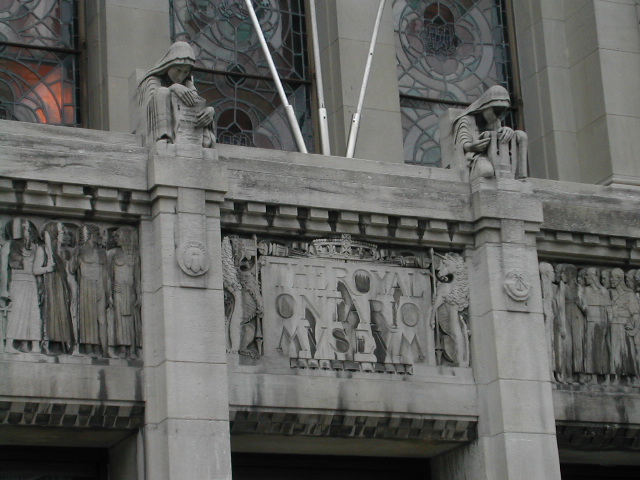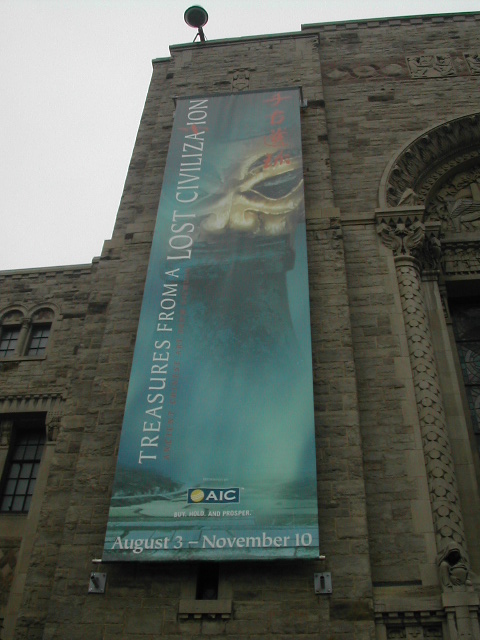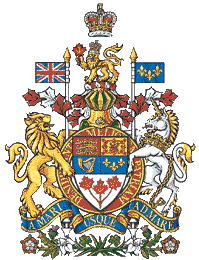
The Royal Ontario Museum

 On Friday Robert and I visited the Royal Ontario Museum, or ROM. The ROM was built in 1914,
by the signing of an Act from the Ontario Legislature. It was created to become one of the worlds leading
public museums. Two men are thought to be chiefly responsible for the success of the ROM. Sir Byron
Edmund Walker was an official with the Bank of Commerce who helped to fund the museum and became a dynamic
force behind its development as a world-class museum. An archaeologist, Dr. Charles Trick Currelly was
responsible for helping the ROM accumulate their �wide-ranging collections of international stature�
(http://www.rom.on.ca).
On Friday Robert and I visited the Royal Ontario Museum, or ROM. The ROM was built in 1914,
by the signing of an Act from the Ontario Legislature. It was created to become one of the worlds leading
public museums. Two men are thought to be chiefly responsible for the success of the ROM. Sir Byron
Edmund Walker was an official with the Bank of Commerce who helped to fund the museum and became a dynamic
force behind its development as a world-class museum. An archaeologist, Dr. Charles Trick Currelly was
responsible for helping the ROM accumulate their �wide-ranging collections of international stature�
(http://www.rom.on.ca).
 Robert and I took the metro from the hotel and traveled up King Street to the museum. The ROM is a
magnificent building; it stands about three stories high on the outside and has two lower levels. In 1978
a $55 million dollar renovation was put underway to expand the museums walls, which were overflowing
with artifacts, specimens, and research materials (ROM 2000/2001 Facts and Figures).
Robert and I took the metro from the hotel and traveled up King Street to the museum. The ROM is a
magnificent building; it stands about three stories high on the outside and has two lower levels. In 1978
a $55 million dollar renovation was put underway to expand the museums walls, which were overflowing
with artifacts, specimens, and research materials (ROM 2000/2001 Facts and Figures).

 Upon entering you are overcome by the large entryway with its marble and pillars. We buy our tickets at
the front counter and open our map to decide where to go first. The floor we are on has all of the
mineralogy exhibits so we decide to stay and look at them for a while. �The ROM has over 45 galleries
which showcase art, archaeology and science. The museum has a total of 273,000 sq. ft. of gallery and
public space�
Upon entering you are overcome by the large entryway with its marble and pillars. We buy our tickets at
the front counter and open our map to decide where to go first. The floor we are on has all of the
mineralogy exhibits so we decide to stay and look at them for a while. �The ROM has over 45 galleries
which showcase art, archaeology and science. The museum has a total of 273,000 sq. ft. of gallery and
public space�
(ROM 2000/2001 Facts and Figures). The ROM has a collection of over 5 million objects.
�3,900,000 are science specimens, and 1,100,000 are art and archaeology artifacts, these items are expected to
grow by 67,000 per year�
(ROM 2000/2001 Facts and Figures). We sort through the massive mineralogy
display and decide to head up to the dinosaurs and mammals. They have several dinosaur skeletons, but I do
have to say that the Smithsonian has many more. Their mammal display is beautiful. Many animals are
arranged in habitats, a good way to view the ecosystem functioning as a whole. We spend about 3 hours
going through these few exhibits and then grow hungry and tired. I suggest we head back to the hotel
and get ready for dinner at Medieval Times. As we leave the ROM, we are counted as two of the 847,045
visitors that visit the museum, on average, each year.

Website created by: Robert Parkhurst and Jennifer Pumphrey













